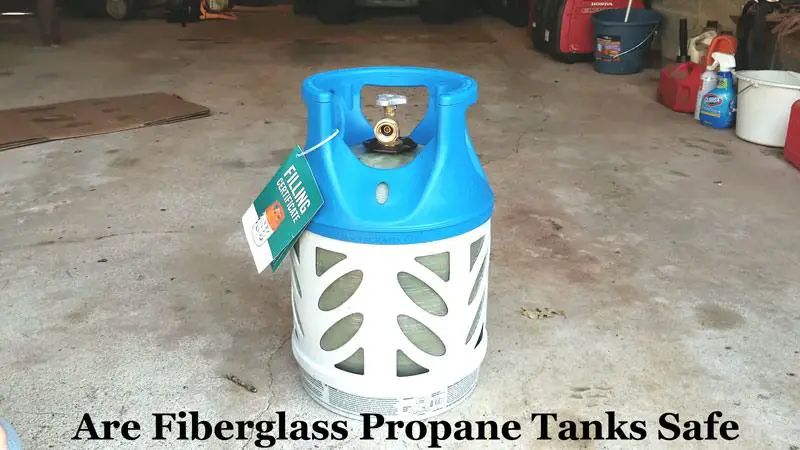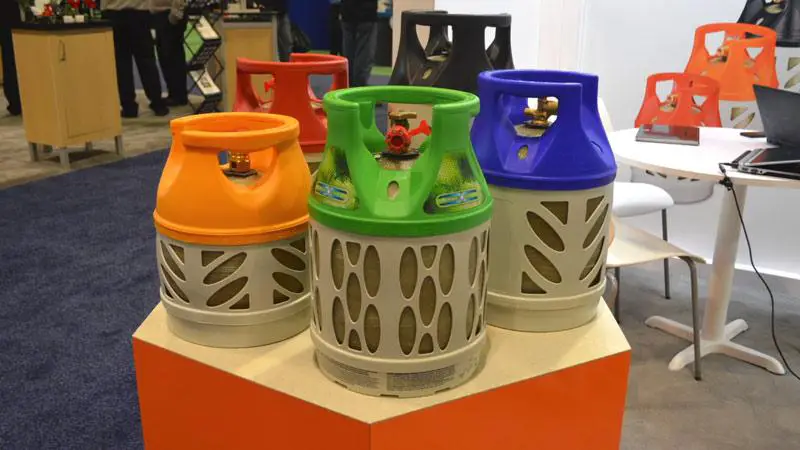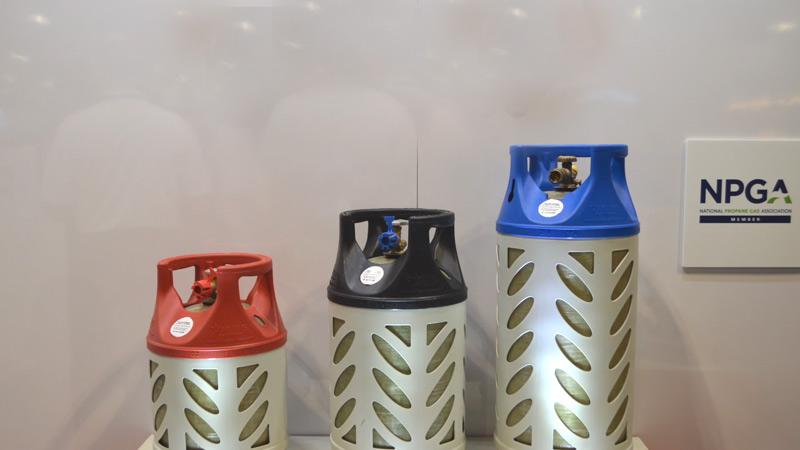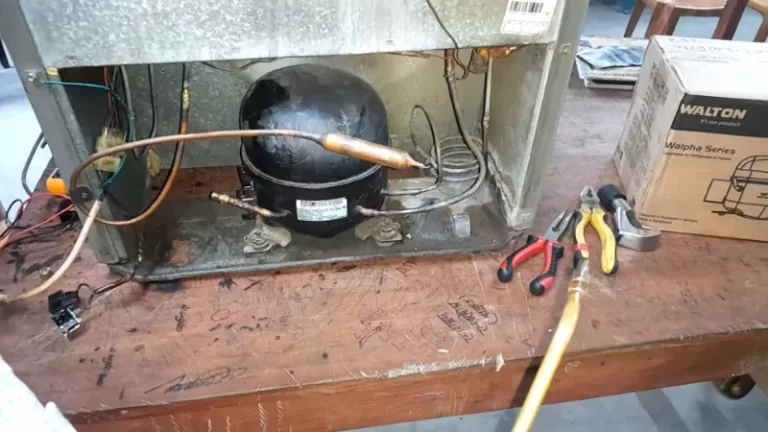Are Fiberglass Propane Tanks Safe

Fiberglass propane tanks are made of a mixture of fibers and plastic resin which makes them safer and lighter than steel or aluminum cylinders. They work with the same equipment as traditional propane tanks, with no need for special adapters. Because they’re made from a durable material, fiberglass tanks can last for years without any problems.
They are more durable than steel or aluminum tanks. They are lighter than steel tanks and the valves are made of stainless steel. Propane tanks are designed to last and to provide years of reliable service.
In this article, we are going to discuss Fiberglass propane tanks, how they are safe and are they good for home, or what size is preferable. Let’s get started.
You'll Learn About
What are Fiberglass Propane Tanks?
Fiberglass propane tanks are a safer, lighter alternative to steel and aluminum propane tanks. They are constructed using a mixture of fibers and plastic resin. Three-layer construction ensures that the tank is completely seamless and the blow-molded liner provides insulation against condensation build-up.
The fiberglass-wrapped plastic casing makes these tanks extremely durable while also being lightweight. These tanks can be used with any standard regulator, making them an affordable choice for homeowners who want an environmentally friendly option for their propane needs.
Fiberglass Propane Tanks Safe
As they are made of fibers and plastic resins, generally they are safe. Fiberglass tanks are less likely to leak than steel tanks. They are safer than aluminum, which can burst into flames in the event of a fire. They are more stable in high-temperature environments and do not generate condensation inside the tank.

Made of a mixture of fibers and plastic resin
These tanks are made of a mixture of fibers and plastic resin, which makes them incredibly safe to operate. They are also lightweight and easy to move around, making them ideal for propane use in the home or outdoors.
Safety Features
The tanks come with safety features built-in, such as an automatic shutoff valve that prevents accidents from happening unnecessarily. Additionally, these tanks have been designed with insulation properties that ensure they don’t overheat during use – even at high altitudes.
Each tank comes with a one-year warranty; so you can be sure you’re getting your money’s worth when you buy one of these products.
Safer and lighter
Although fiberglass propane tanks are not as common as steel, aluminum o,r plastic cylinders, they are considered to be a safer option when it comes to storage and transportation. Propane tanks made from fiberglass are much lighter than those made from other materials, making them easier to transport and store in your home.
Don’t Corrode As Metals Do
They also do not corrode like metal cylinders over time and can last for many years without any maintenance required. If you have ever used a steel cylinder, then you know that they can be heavy and hard to handle when filling them with propane gas.
However, because fiberglass tanks are so lightweight, transferring the propane gas into them is easy – even for someone who has never filled one before. Fiberglass tank technology has come a long way since these first prototypes were developed more than four decades ago.
No need for special adapters
If you are looking for a specific type of tank, such as fiberglass or propane tanks, work with the same equipment without needing special adapters. This is because these tanks use the same gas and plumbing systems- no need to worry about compatibility.
Furthermore, since these tanks do not require any extra maintenance as other types of tanks- there is no reason to be afraid of them leaking while in use. In fact, if you have an existing propane tank that needs replacing but does not have a compatible adapter available- simply install a fiberglass one instead.
Different Sizes and Shapes
They also come in different sizes and shapes so there is sure to be one perfect for your home’s needs.- whether it’s for cooking or heating purposes. Lastly, make sure you consult with professionals before making any decisions about altering your home appliances – they are experts after all.

Notes:
If you ever have to replace your tank, be sure to get one that’s specifically designed for use with fiberglass fuel cartridges – these are usually much cheaper than standard tanks. Always read the manufacturer’s instructions before using your tank – if there are any questions or concerns, don’t hesitate to contact them directly.
Composite Propane Tank Is It worth It
Composite propane tanks are made from a combination of plastic and metal. They’re often seen as safer than traditional propane tanks because they don’t contain any gas or oil.
However, there have been cases where these tanks have exploded due to a defect in the manufacturing process. So far, no one has been injured by a composite tank explosion, but it’s still worth being aware of the risks involved.
Safer Than Traditional
Composite propane cylinders are much safer than traditional propane tanks. They don’t explode in a fire, and they are also lightweight and translucent which makes them easy to transport. You can check the level of gas at any time using a simple gauge or by reading the markings on the tank itself.
No Explosion
There have been no reported cases of composite propane cylinders exploding in a fire, which is why they are often used as backup generators for households or small businesses.
Contains No Metal Parts
Because composite propane cylinders do not contain any metal parts, they are extremely safe when it comes to fires – even those that involve gasoline or other combustible materials.
Replace if Leaking
If you ever notice your composite propane cylinder leaking gas, it is important to get it replaced right away as this could lead to an explosion if not taken care of properly. If you have any questions about whether or not composite propane cylinders are safe for your use, please feel free to reach out to the expert team at any time.
Are the residential propane tanks safe?
In the event of a propane leak, it is important to take steps to ensure your safety. Residential propane tanks are safe and reliable – even in the event of a leak.
If you smell gas emanating from your residential propane tank, be sure to call your local fire department immediately. Make sure that any potential repairs or replacements for your residential propane tank are done by an authorized professional – non-toxic and odorless fumes can be dangerous if not handled correctly.
Can propane tanks just explode?
It depends on a variety of factors, including the age and makes of your tank, how well it’s been maintained, and what else is nearby.
But in general, propane tanks can sometimes explode if they’re not properly inspected or if there are any problems with their construction. Let’s discuss the situations:
Not Properly Stored
Improper storage of propane tanks can lead to them exploding. If the tank is not properly stored, it may become overstuffed with gas or liquid and this could cause it to explode.
Leaks
Leaks in a propane tank may also be enough to cause an explosion. These leaks can come from the valve stem, regulator, or fittings on the tank itself.
Fuel Overload
Overloading a propane tank can also lead to an explosion. This occurs when you put too much fuel into the tank at once and causes pressure buildup inside of it which eventually leads to an explosive reaction.
Ignition Near the Tank
Smoking, cooking, or lighting near a propane tank can also result in an explosion due to heat generation within the container itself.
Faulty Cylinders
Defective cylinders are another common source of Propane Tank explosions. Cylinders that are not manufactured correctly may have defects that increase the risk of rupture during use
Which gas cylinder is best for home use?
There are a few factors to consider when deciding which gas cylinder is best for home use. This includes the size of your home, the type of fuel you will be using, and how often you plan on using it.
Low Boiling Point
Butane gas has a low boiling point, which means that it will continue to vaporize even at low temperatures. This makes butane the ideal choice for use in cold weather environments because it is easier to transport than other types of gas cylinders.
Easier To Transport Than Butane
Butane is lighter and smaller than other types of gas cylinders, making it easier to transport from one location to another. It also doesn’t require any special handling or preparation before use, so you can quickly and easily get started using your butane cylinder without any hassle.
Continues To Vaporise Even In Low Temperatures
The colder the environment outside your home, the more efficient butane will be at vaporizing into gases such as CO2 and H2 O molecules needed for combustion inside your stovetop or heating system.
More Economical Than Other Types Of Gas Cylinders
Butane is less expensive than other types of gas cylinders when bought in bulk quantities – this makes it an economical option if you plan on using your stovetop or heater frequently throughout the year. 5 . Better For Short-Term Use Only
How Long Will My 250 Gallon Propane Tank Last?
A 250-gallon propane tank should last for about 6 to 8 hours if used continuously in a residential setting. If you only use it occasionally, the tank may last for up to 12 hours.

How Much You Burn Per Day
The lifespan of a propane tank will depend on how much you use it each day. If you only use your tank for occasional fires, then the tank may last up to 7 months and 2 days. However, if you regularly burn through your propane tanks quickly, the lifespan may be shorter.
For example, using a 250-gallon propane tank that is only used for 5 hours per week would likely last around 3 months. Also, they will last too short for a big house. They might be empty without noticing that you can test without a gauge.
Size Of Your House Indirectly Impact
The size of your house has a small impact on how long a 250-gallon propane tank lasts. Let’s break it down:
- If your house is bigger or smaller than average, the size of your propane tank won’t have a significant impact on its longevity.
- In fact, even if your house has a small 200-gallon propane tank as opposed to a larger 500-gallon one, both tanks can typically hold fuel for around 6 months before they need to be replaced or refilled with new gas.
- 250 gallons is enough to fill up multiple rooms with heating needs in a single trip out and back home from the store
- A single trip out and back from most stores can fill up at least two rooms with heating needs – so having more than one 250-gallon propane tank will not make sense unless those extra tanks are being used frequently throughout the year (for instance during cold winter months).
To Recap
To conclude, we can say that the fiberglass tanks are very safe to use in your homes and small businesses.
Frequently Asked Questions
How To Mount Fiberglass Propane Tanks?
You can mount them in a variety of ways, from using gas caps, to installing them with the tank valves facing up, to using only the steel mounting rings.
How Does A Propane Tank Valve Work?
A propane tank valve works in a simple way. A valve stem is attached to a rubber diaphragm. The diaphragm is placed inside the tank. When the tank is full, the diaphragm seals the tank, preventing the gas from escaping. When the tank is empty, the diaphragm lifts off and allows the gas to flow through the valve.
How Do I Know If My Propane Tank is a Fiberglass Tank?
Fiberglass tanks are marked with the word “Fiberglass” on the tank. Fiberglass propane tanks are lighter, safer and more durable than steel tanks.
How Do You Seal Black Gas Pipes?
We recommend the use of a compound of carbon black and Teflon. It’s quick and easy to use and it seals up black gas pipes very effectively.
Do Fiberglass Propane Tanks Have A Safety Seal?
Yes, Fiberglass tanks are manufactured with a safety seal that is puncture resistant. This allows the tank to be completely sealed off from the environment.
How Do I Install a Fiberglass Propane Tank?
Simply slide the tank over the fill neck and fill the tank. Be sure to tighten the valve in place and install the regulator and fill cap.
How Do I Remove a Fiberglass Propane Tank?
All you need to do is unscrew the fill cap, unscrew the regulator, then unscrew the tank from the tank valve.
What Is Carbon Black?
Carbon black is a black powder that is produced from the burning of coal. It is widely used to increase the brightness of dyed fabrics. It’s the black that you see in dyed denim jeans and is also used to color liquid petroleum gas tanks.

